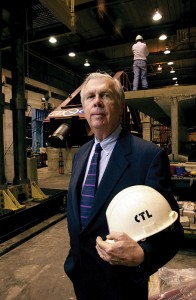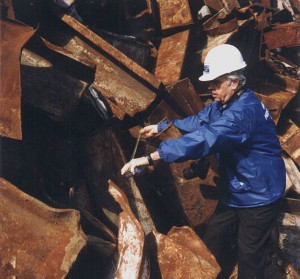The Structural Engineering Community Mourns the Loss of an Innovative Leader
On March 1st, the structural engineering community was saddened by the news of the passing of Dr. Gene Corley after a brief battle with cancer. At age 77, Dr. Corley had accomplished much in his career, but was most notably known for his investigation of the collapse of the World Trade Center towers after the terrorist attack on September 11, 2001. A recognized industry leader, Gene was at the forefront of the structural engineering profession, and the development of building codes and standards.
W. Gene Corley was born in in 1935, the son of the late Clarence W. and Mary Douthit Corley of Shelbyville, Illinois. Gene was influenced from a young age by his father, a contractor who built single-family homes, shopping malls and grocery stores. In an interview with Dr. Corley by the Chicago Tribune in 2001, Gene mentioned that “I was on building sites even before I was big enough to crawl.” He graduated from Shelbyville High School in 1954 and went to study architecture, but didn’t think he could draw well enough. An early indicator of his dedication to the field of structural engineering was his commitment to his education, receiving a Bachelor of Science Degree in Civil Engineering (1958), and a Masters (1960) and Doctorate in Structural Engineering (1961), all from the University of Illinois.
Upon completion of his Ph.D., he served as a commissioned officer in the U.S. Army. During this period, Dr. Corley was a research and development coordinator with the U.S. Army Corps of Engineers at Fort Belvoir, Virginia. His duties included bridge design, acceptance testing of mobile floating assault bridge equipment, design of tank launched bridges and fatigue testing of bridges fabricated from high strength steel, aircraft aluminum and titanium alloys.
In the 1960s, Gene turned down a job with NASA working on the lunar rover program, and took a position at the Portland Cement Association (PCA), a nonprofit that represents cement companies. According to Gene, “After I finished my Ph.D at the University of Illinois, I spent three years in the military. At the end of that, I interviewed all over the state. I had some fantastic opportunities at that time. It was a really good time for engineers to look for work. I actually had offers for more money to do other things, but I felt that the offer from the Portland Cement Association was exactly in line with what I’d been trained to do, and was my best opportunity…”
As demand for consulting grew, the research and development laboratory for PCA was eventually spun off as a for-profit company, expanding into other building materials and engineering issues and offering engineering, testing, and consulting services. First known as Construction Technology Laboratories, the firm changed its name to CTLGroup in 2005 to reflect the fact that it provided both laboratory services and engineering consulting services.
When CTLGroup first became an independent subsidiary, it expanded its scope of services beyond concrete and modified its structures laboratory to incorporate the testing of steel structures. While serving in successively more responsible positions, Dr. Corley was directly involved in the development of improved design procedures for structural concrete, concrete pavement, railroads and structures subjected to fire loads. In addition, he served on earthquake damage investigation teams, carried out investigations of damaged or deteriorated structures and developed repair procedures for numerous buildings and bridges.
Gene served as an expert advisor during the investigation and trial resulting from the 1993 fatal fire at the Branch Davidian complex in Waco, Texas. In 1995, Dr. Corley led the investigation of the structural performance of the Alfred P. Murrah Federal Building in Oklahoma City, following the bombing there. He served as the head of the Building Performance Assessment Team (BPAT) which involved the American Society of Civil Engineers, as well as representatives from the Federal Emergency Management Agency (FEMA), the United States Army Corps of Engineers, the General Services Administration, and the National Institute of Standards and Technology.
Commenting on how his career evolved, Gene highlighted the emergence of “forensic” engineering. “…there definitely have been big changes. One of the changes is that at the time I was hired as a development engineer for the PCA laboratories, the science of construction forensic work really didn’t exist. There were very few people doing anything like that at the time. When I started with PCA, I was doing work to develop new design concepts and better ways to use concrete. Really most of my work dealt with ways to develop more economical and safer high-rise buildings. That’s what I started doing. Then, as I progressed in my experience, I was put in charge of all engineering uses of concrete … as time went along, I started getting hired as a consultant on jobs where people either wanted to do things that were unusual -that hadn’t been done before -or they had tried to do something and had run into trouble and needed help in finding a solution to the problem. That led into the investigation of more and more troubled structures and eventually into the investigation of collapses -finally, of major collapses and major problems with structures of all types.”
Dr. Corley built his reputation as one of the world’s experts on structures damaged by natural and manmade disasters as he investigated some of the most notable building failures in recent U.S. history, earning him the label of the “preeminent expert on building collapse investigations and building codes” by the American Society of Civil Engineers (ASCE).
As the nation and the world watched coverage of the September 11, 2001 attack on the World Trade Center’s (WTC) twin towers, the following fires, and the eventual collapse of the World Trade Center Towers, the engineering community immediately began to ask questions: How were the towers able to withstand the enormous impact of a 767 without collapsing? Could anything be done to make the buildings survive longer in the ensuing fires? To help answer these questions, the American Society of Civil Engineers/Structural Engineering Institute and FEMA joined together to study the performance of collapsed and damaged buildings, and asked Dr. Corley to lead the team. With the cooperation of nearly a dozen other societies and organizations, this team of 23 Structural and Fire Protection Engineers completed their work on May 1, 2002.
Gene would describe the methodologies and findings of the WTC investigation in later interviews. “There are usually two parts to any investigation like that. The early investigation needs to be done rapidly and with whatever resources are available at that point, and from that first investigation, recommendations can be made for, in some cases, further investigations, and for whatever can be done differently, such as changes in building codes… we had to find out what happened at the WTC, to preserve evidence of what had happened, and to recommend what additional work, if any, needed to be done.”
“We found one piece of steel across the street from Tower 1 and by reading the numbers on it, we could identify that it was from the area above where the aircraft went in, and where there was fire in Tower 1. The building it was imbedded in had no fire in it. By looking at the piece of steel, we could see that on one end, it showed no indication of fire, and that end was in a position low enough to be below the fire, but the other end was smoke-coated and had fire damage. This showed something very important, and that was that at the time it was in the fire there was no fire-proofing on that piece of steel. That was important in bringing us to the conclusion which the National Institute of Standards and Technology (NIST) came to also, i.e., that when the planes hit the buildings, they knocked off fire proofing from the steel and that left the steel more vulnerable to fire after impact.”
W. Gene Corley authored hundreds of technical papers and books, and frequently lectured on the subjects of prevention of failures, effects of earthquakes and design and repair of structures. Dr. Corley was passionate about codes and standards that affect structures, and chaired ACI Committee 318 for six years as the committee developed the 1995 Building Code Requirements for Structural Concrete. He also served on several other national and international committees that prepared recommendations for structural design and for design of earthquake resistant buildings and bridges. His professional activities resulted in his receiving numerous national and regional awards. Dr. Corley served in leadership roles for several professional organizations, both national and international, including the National Council of Structural Engineers Associations (NCSEA), the Structural Engineers Association of Illinois (SEAOI), the Illinois Structural Engineering Board (ISEB), the National Council of Examiners for Engineering and Surveying (NCEES), and the ASCE/SEI Technical Council on Forensic Engineering.
Notably, Gene was instrumental in the formation of NCSEA. As a past president and leader of SEAOI, he, along with Jim Cagley, Paul Fratessa (deceased), and a few others, founded NCSEA in 1993. Gene served on the first Board of Directors and was the fourth NCSEA President, from 1996-1997. During his presidency, the organization recapitalized, moved its offices, and hired a new executive director. Gene loaned his talents and prestige to the upstart organization and was instrumental in its success. He was passionate regarding the role of structural engineers in the protection of the public.
Dr. Corley also strongly supported licensing of structural engineers. “The structural engineer is the only one always responsible for life safety,’’ said Corley. “To provide life safety takes a level of knowledge in structural engineering. It is not enough to know civil engineering.”
“Gene’s legacy in the structural engineering profession is unparalleled. He was an innovative thought leader who consistently contributed generous amounts of his time and knowledge to the profession,” said Jeffrey L. Garrett, Ph.D., S.E., CTLGroup President & CEO.
Dr. Corley’s interest in the structural engineering profession was demonstrated daily by his tireless efforts in helping state structural engineering associations, giving technical presentations and seminars, and teaching examination review courses. He didn’t leave a list of monumental structures for the world to remember him by; and there are no bridges or high rise buildings associated with his name. Gene left something much more significant. He left a legacy of service to the profession of structural engineering, along with a reputation of integrity, astounding knowledge, and class.
Gene Corley is survived by his wife of 53 years, Lynd, three children (Anne, Bob, and Scott) and nine grandchildren. Please join NCSEA, SEI, CASE and STRUCTURE magazine in sending condolences to Dr. Corley’s family.▪
Quotes attributed to Dr. Corley were taken from an interview conducted by Laurence W. Johnson of the Skokie Public Library in 2011, transcripts of numerous committee meetings, and general comments recorded in the press.


